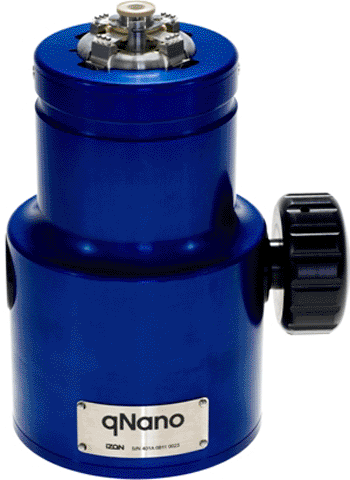Resistive Pulse Sensing Allows Measurement of Individual Biological Particles
By LabMedica International staff writers
Posted on 02 Aug 2012
An international team of biotech researchers has used an ultrasensitive nanoparticle analysis system to detect and measure the agglutination of biological molecules at the level of the individual particle. Posted on 02 Aug 2012
The team comprised of investigators from Loughborough University (Leicestershire, United Kingdom) and University College Dublin (Ireland) worked with an Izon Science (Christchurch, New Zealand) qNano instrument.

Image: The qNano bench-top nanoparticle analysis instrument (Photo courtesy of Izon Science).
The qNano uses resistive pulse sensing to monitor individual and aggregated rod-shaped nanoparticles as they move through tunable pores in elastomeric membranes. A discrete blockade event signal is recorded by the system each time a particle traverses the nanopore. The magnitude of a measured blockade signal is a key indicator of the volume (or equivalent diameter) of the particle that has passed through the pore.
The qNano instrument is described by its manufacturer as a rapid, accurate, and convenient solution for evaluation of particle size and size distribution of nanoparticle samples in a fluid. Particle-by-particle detection ensures an accurate size distribution output without the averaging effects inherent in other size analysis technologies.
In a paper published in the May 9, 2012, online edition of the journal Small the investigators described the use of the qNano instrument to investigate the agglutination of biological molecules. By controlling the surface chemistry and location of the capture ligand, molecular rods were made to form either long “end-on-end” or wide “side-on” aggregates upon the addition of an analyte. They demonstrated the binding of a biotinylated target to an avidin capture probe, followed by the detection of platelet-derived growth factor (PDGF-BB) using an aptamer capture probe, with limits of detection down to femtomolar levels. This observation will facilitate multiplexed detection in agglutination assays, as particles with a particular aspect ratio can be distinguished by only two measurements.
First author Dr. Mark Platt, lecturer in analytical chemistry at Loughborough University, said, "The strength of using the qNano is its simplicity and the ability to interrogate individual particles through a nanopore. This allowed us to establish a very sensitive measurement of concentration because we could detect the interactions occurring down to individual particle level. By comparing particles of similar dimensions we demonstrated that the resistive pulse signal is fundamentally different for rod and sphere-shaped particles, and for rod shaped particles of different lengths. We could exploit these differences in a new agglutination assay to achieve these low detection levels."
"This is a real milestone for Izon's technology as being able to measure biomolecules down to these extremely low levels opens up new bio-analysis options for researchers. 10 femtomolar was achieved, which is the equivalent dilution to one gram in 3.3 billion liters, or one gram in 1,300 Olympic sized swimming pools," said Hans van der Voorn, executive chairman of Izon Science. "We are now developing standardized diagnostics kits for researchers which will allow them to optimize protocols for their particular targets of interest."
Related Links:
Loughborough University
University College Dublin
Izon Science














